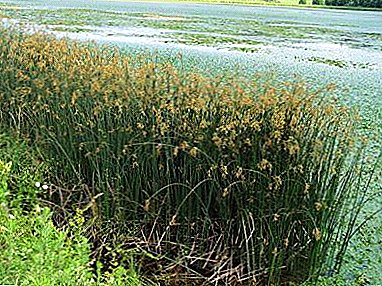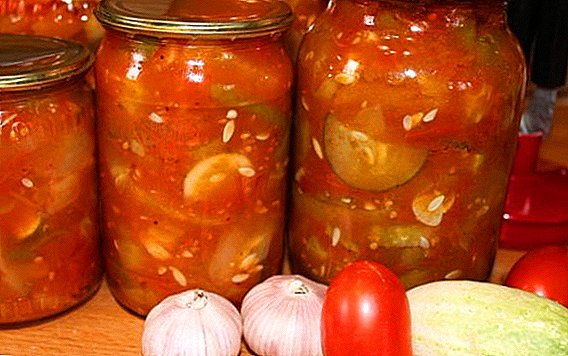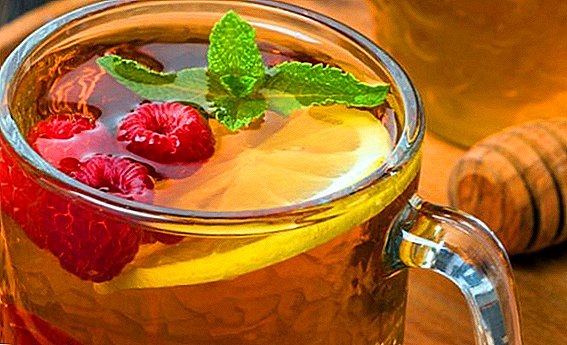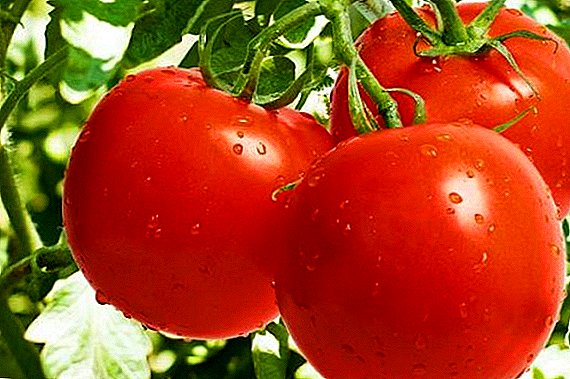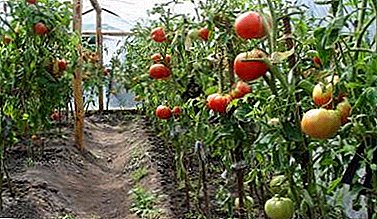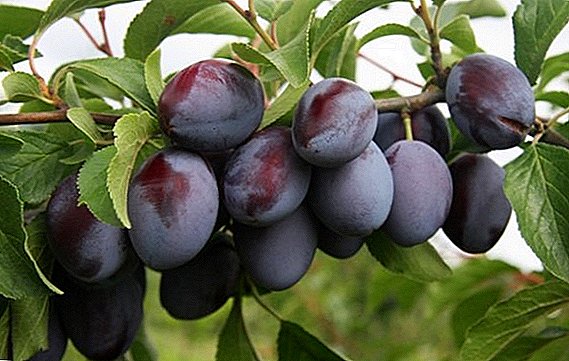 Plum is not only a storehouse of useful substances, but also a very tasty product. Therefore, each gardener, choosing a fruit tree for his garden, wants it to please him with a good harvest as often as possible. Breeders take care of increasing yields. It was they who brought the universal self-fertile variety of home-made plum called "Bogatyrskaya". Because of its simplicity, the tree gives a harvest in large quantities and a long time. In more detail about a grade we will tell in article.
Plum is not only a storehouse of useful substances, but also a very tasty product. Therefore, each gardener, choosing a fruit tree for his garden, wants it to please him with a good harvest as often as possible. Breeders take care of increasing yields. It was they who brought the universal self-fertile variety of home-made plum called "Bogatyrskaya". Because of its simplicity, the tree gives a harvest in large quantities and a long time. In more detail about a grade we will tell in article.
Inference history
This sort of plum turned out by crossing the "Hungarian local" and "Giant". Selection involved Soviet scientists R.V. Korneev and V.A. Korneev. The work was carried out in the Lower Volga Research Institute of Agriculture.  In 1962, they tested the variety at the state level. And in 1987, the variety was brought to the State Register.
In 1962, they tested the variety at the state level. And in 1987, the variety was brought to the State Register.
Did you know? Home plum appeared from the crossing of cherry plum and thorns.
Tree description
The young tree in its growth rate seems to be tall. Over time, the growth rate slows down, and the tree becomes medium. The crown of the plum "Bogatyrskaya" is wide, relatively thick. It is formed from branches extending from the trunk at an acute angle.
You will also be interested to learn about the cultivation of such varieties of plums such as "Anna Shpet", "Honey White", "Morning", "Eurasia", "Stanley".
It is difficult to call straight branches. The bark of the tree is gray, constantly peeling off. Plum gives strong, not long and not thick shoots of gray-brown color.
Brown conic buds are formed on them. Of them appear ovate-shaped with a corrugated surface of green leaflets. The bottom of the sheet is lighter than the top. Blossoms plum white. Flowers are double or triple. The flowering period begins in May. 
Fruit Description
The fruit of this variety is quite large. On average, it weighs 30-40 grams, some may be 60 grams. The shape is oval, elongated. Have a pronounced groove. The greenish yellow sweet and sour and juicy flesh is hidden behind the dark purple skin. From above the peel is covered with a wax raid.
Stone is comparable in size with the size of the fetus and is about 8% of its weight. To separate it from the pulp, you need to put a little effort.
Learn also about the peculiarities of the cultivation of peach plum, Chinese plum, Hungarian plum, self-fruited plum, yellow plum, columnar plum.
Bogatyrskaya plum is a universal variety, i.e. it can be used for any purpose. Its fruit contains 12.66% sugar, which allows you to cook from them jam and sugar-free jam. You can also cook compotes or just eat fresh. 
The main characteristics of the variety
Now we give a brief description of the variety. This will help to know its features better.
Drought resistance and winter hardiness
The variety has increased winter hardiness. It tolerates frosts easily. He does not like increased humidity, especially if the roots are dwelling. In severely arid places does not survive. Needs periodic watering.
Disease and Pest Resistance
Plum "Bogatyrskaya" is characterized by increased resistance to diseases and pests. Of course, one cannot argue that if a variety is stable, then diseases will bypass it. Under certain conditions, an absolutely healthy tree can suddenly hit a disease.
Learn more about how to deal with the diseases and pests of plums, especially with coccomycosis in plums.So that this does not happen, you should better know about the most common diseases of plums.

- Holey spotting. This is a type of fungal disease, manifested in the rainy season and at high humidity. The disease affects the leaves and fruits. They are formed holes. To prevent the appearance of fungus, it is necessary to clean and destroy dead foliage in time.

- Comedication Gum, or resinous substance, appears on the sections of the branches and in the cracks of the bark. Actively develops with high humidity and rain. For preventive purposes, avoid mechanical damage to the plant.

- Fruit rot. It flourishes during the ripening period. Because of her they are covered with gray spots. Rot blown by the wind. When a disease is detected, all infected fruit must be disposed of.

- Hawthorn. This is a caterpillar that eats young buds. Because of this, the tree's yield is deteriorating. In order to avoid the appearance of a pest, dry leaves should be collected on time and the ground and tree should be checked for the presence of caterpillar nests. In the fight against them is used "Aktellik". They sprayed the plant.

- Shoot moth. Attacks buds, foliage and ovary. Carefully loosen the ground and check it for caterpillars. Sprayed wood "Aktar" when the buds swell.

Pollination
The variety is self-fertile, so there is no need to plant pollinating trees. They also do not need insect pollinators. The flower of self-growing plants has a boot and a snout located on one level. And before the flower opens, it will already be pollinated.
Terms of flowering and ripening
In terms of flowering and fruiting plum "Bogatyrskaya" refers to the late varieties. The flowering period falls on the beginning of May, and the fruits ripen in the last decade of August.
Fruiting and Yield
The sapling begins to bear fruit in the fourth or fifth year. It gives a bountiful and regular harvest. From young stock you can collect 50-70 kg of plums. With age, fertility rises to 60-80 kg. Trees yield up to 15-30 years. Duration of fruiting depends on vaccinations.
Important! Plum fruits “Bogatyrskaya” is so large and growing so thickly that, if not thinned out and not picked in time, they can easily break branches.

Growing conditions
When choosing a plot for plum planting, please note that the variety does not like shade and drafts. The tree needs constant access to the light, otherwise it will begin to fade, and yields will fall. Does not like the plant when its roots are flooded with groundwater.
Therefore, they should not go closer than one and a half meters to the soil surface. The fertile layer must have neutral acidity.
Learn about the importance of soil acidity, how to determine acidity, how and what to deoxidize.
If the soil in your area is sour, then it should be filled with ash or dolomite flour in the amount of 800 g per square meter.
After the earth is dug up. The type of soil can be almost any. But if there is a lot of clay in the soil, then sand should be poured into the pit. And if the soil is sandy, it is clay. 
Landing rules
Having decided to plant a plum in your home, decide on the landing dates. You can carry out the procedure in the fall until mid-October and in the spring, until the buds have blossomed. The choice of the season depends on when you need to prepare the ground.
If spring works are planned, the ground is prepared in October. When planting in autumn, the soil should be prepared two to three weeks before planting. Next you should choose a sapling.
Buy it is recommended in special nurseries. The best option is a one-, two-year-old sapling meter and a half height and with a trunk size of 40-60 centimeters. The root system should be developed and consist of four to five roots with a length of 25-30 centimeters.
In order to preserve the purchased seedling before planting, it is necessary to wrap its roots in a damp cloth so that they do not dry out. If you are going to plant a tree in a few months, then it is added with earth, deepening 35-40 centimeters into the soil. 
Landing is as follows:
- Digging a hole 50 (60) x 80 centimeters. Between the pits reserve three meters. The first 30 cm of soil are removed and folded separately. This is the most fertile layer.
- We determine the center of the pit and at a distance of 15–20 cm from it we dig in a peg for support. It is necessary to bind to it a young plant.
- The remaining soil layer is mixed with a bucket of manure, 300 g of superphosphate and 65 g of potassium salt.
- When the seedling root system dries, it should be immersed in water for 8-10 hours. If dead roots are found, they should be removed.
- The fertile layer of earth is laid out at the bottom of the pit with a hillock. A sapling is placed on it, its roots are carefully straightened and covered with soil so that the root neck is 3-4 cm higher than the ground level.
- We tamp the soil and water the plant with 40-50 liters of water. Pristal circle is covered with humus or peat from above.
- The tree is tied with flexible twine to the support.
Important! Place the seedling in the pit so that it is on the north side of the support.

Seasonal care features
Properly planted plants require proper care. Although the variety of plum "Bogatyrskaya" is considered unpretentious, but some particular care should be known.
Watering
Watering needs careful, plentiful. But we can not allow overmoistening and stagnant water. This is detrimental to the health of the plant. With increased humidity, fungi begin to develop.
A freshly planted plant is sufficient to be watered once every seven days with two or three buckets of water. Matured trees require less frequent irrigation.five to six times a season. At the same time you need to pour four buckets under the tree.
But if the plum enters the stage of the formation of the fruit, then it will need six to eight buckets. 
Top dressing
The seedling does not need additional feeding during the year. It only needs to be sprayed with growth stimulants. The fruit-bearing plant is fed three times per season.
To growth stimulants include drugs such as "Kornerost", "Chunky", "Seed", "Etamon", "NV-101", "Pollen", "Bud".The following scheme works:
- Before flowering, carbamide is used in a dosage of 45 g per 10 liters;
- during the maturation of the crop using nitrophoska at a dosage of 30 g per 10 liters;
- at the end of the harvesting, feed with superphosphate at a dosage of 30 g per 10 liters. Here it should be noted that the tree should receive 30 liters of fertilizer.
Also in late autumn, the tree should be fertilized with a manure bucket. The above feeding scheme is used for plums younger than 15 years. Older trees need half the dose. Fertilization frequency - every year. 
Soil care
Loosen the soil around the tree every summer. This will allow time to identify pests. Weeds need to be removed regularly until the tree is strong and begins to bear fruit. Around an adult plant weeds are weeded only in spring. Mulch for the winter.
Pruning
Plum annually should do formative pruning. For this variety, pruning is not only a way to create the correct crown shape, but also an opportunity to prevent the development of certain diseases.
Since the branches of the plant are often overloaded with fruits, it is necessary to cut off all weak branches and not growing at right angles to the trunk. In this way, a longline sparse crown is formed.
At the planting in the spring of an annual sapling pinch tip. This activates the growth of shoots on the sides. If a two-year-old sapling is planted, then its branches are cut by a third. In the planted plants in the autumn period pruning is carried out in the spring.  After, before each appearance of swollen buds, forming pruning is performed. In the spring and autumn they perform sanitary pruning to remove diseased and dead branches, shoots. Also cut off the branches growing inside the crown.
After, before each appearance of swollen buds, forming pruning is performed. In the spring and autumn they perform sanitary pruning to remove diseased and dead branches, shoots. Also cut off the branches growing inside the crown.
It is also important to remove root growth and thin out the ovary.
Preparing for the winter
Even the most cold-resistant plants need minimal preparation for the winter.
Fallen leaves are removed under the tree, the ground is dug, the last abundant watering is carried out and the lower part of the trunk is covered with lime.
To protect against rodents, the trunk is wrapped with burlap and roofing felt. 
Advantages and disadvantages
Positive qualities of the variety:
- abundant and stable fruiting;
- high resistance to low temperatures;
- self-fertility;
- Fruits are stored for a long time and perfectly tolerate transportation;
- disease resistant;
- harvesting can be done mechanically.
Negative qualities:
- because of the abundant harvest branches need props;
- if you do not thin out the ovary, the fruits will be small;
- begins to bear fruit from 4-5 years.
Did you know? In the world each year around three million tons of plums are harvested.
 Thus, it can be concluded that the plum layer described can take root in almost any climate due to its self-fertility. With proper care, the tree will delight you with juicy, large fruits. Their high keeping quality allows you to make vitamin reserves for the winter.
Thus, it can be concluded that the plum layer described can take root in almost any climate due to its self-fertility. With proper care, the tree will delight you with juicy, large fruits. Their high keeping quality allows you to make vitamin reserves for the winter.Feedback from network users



